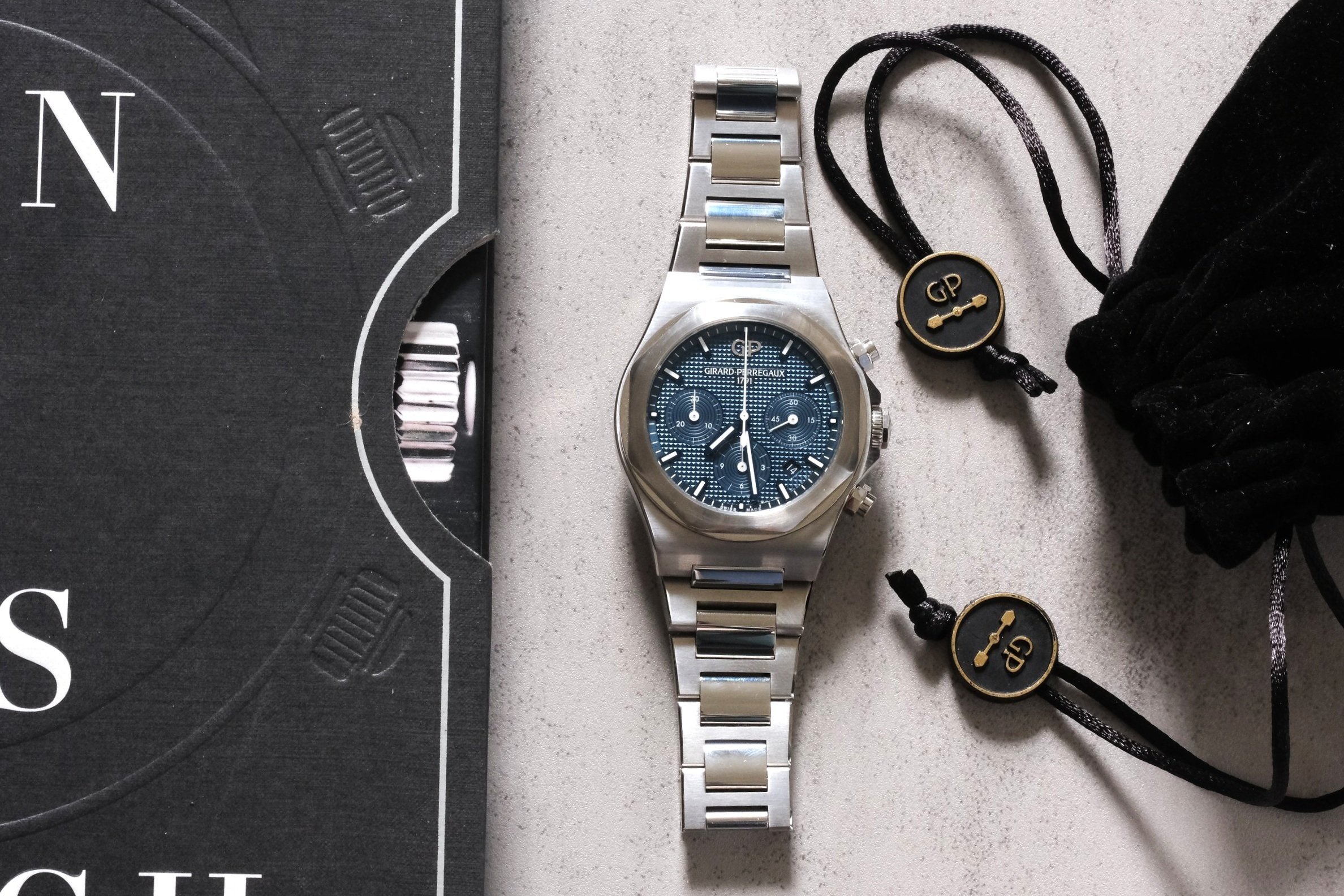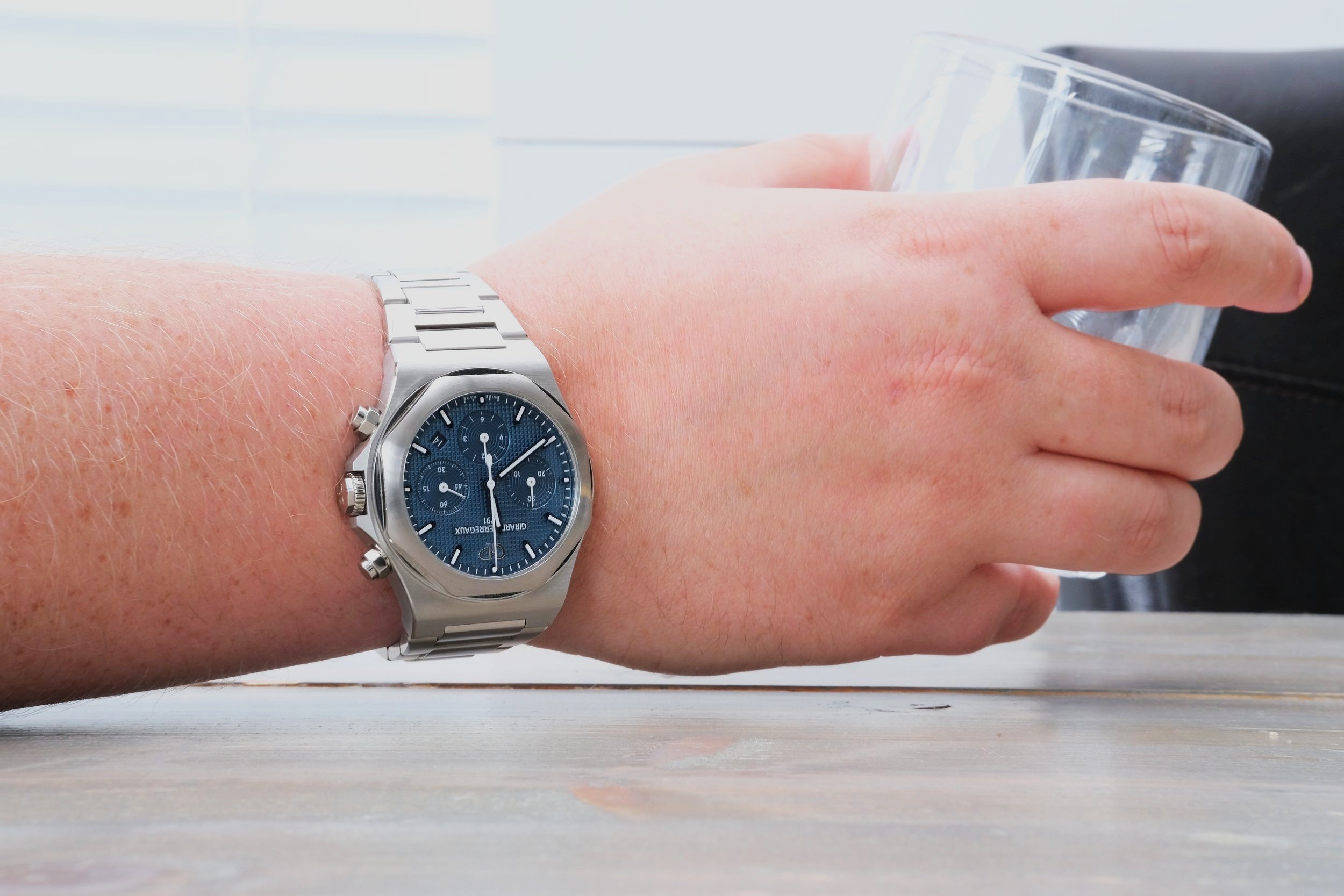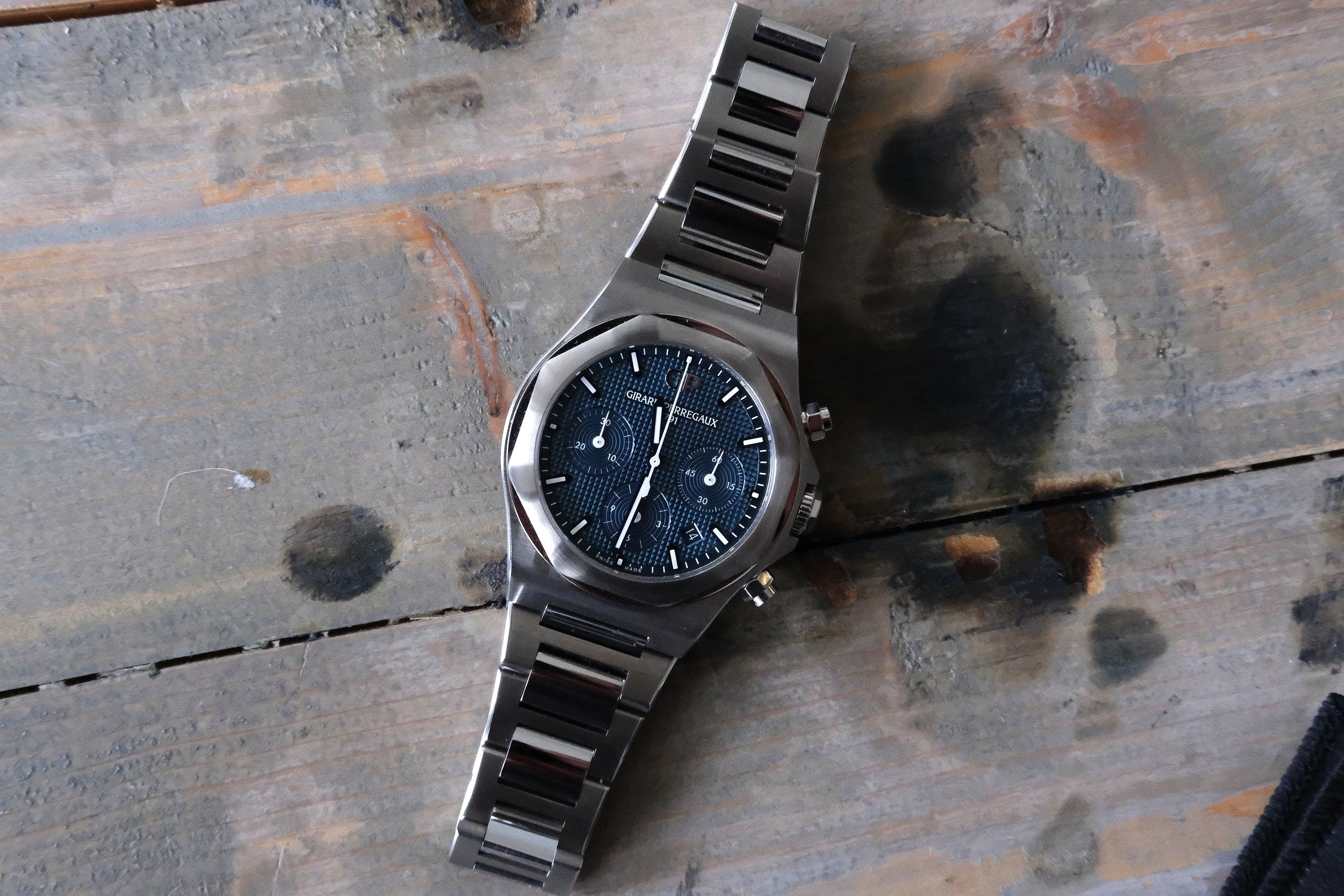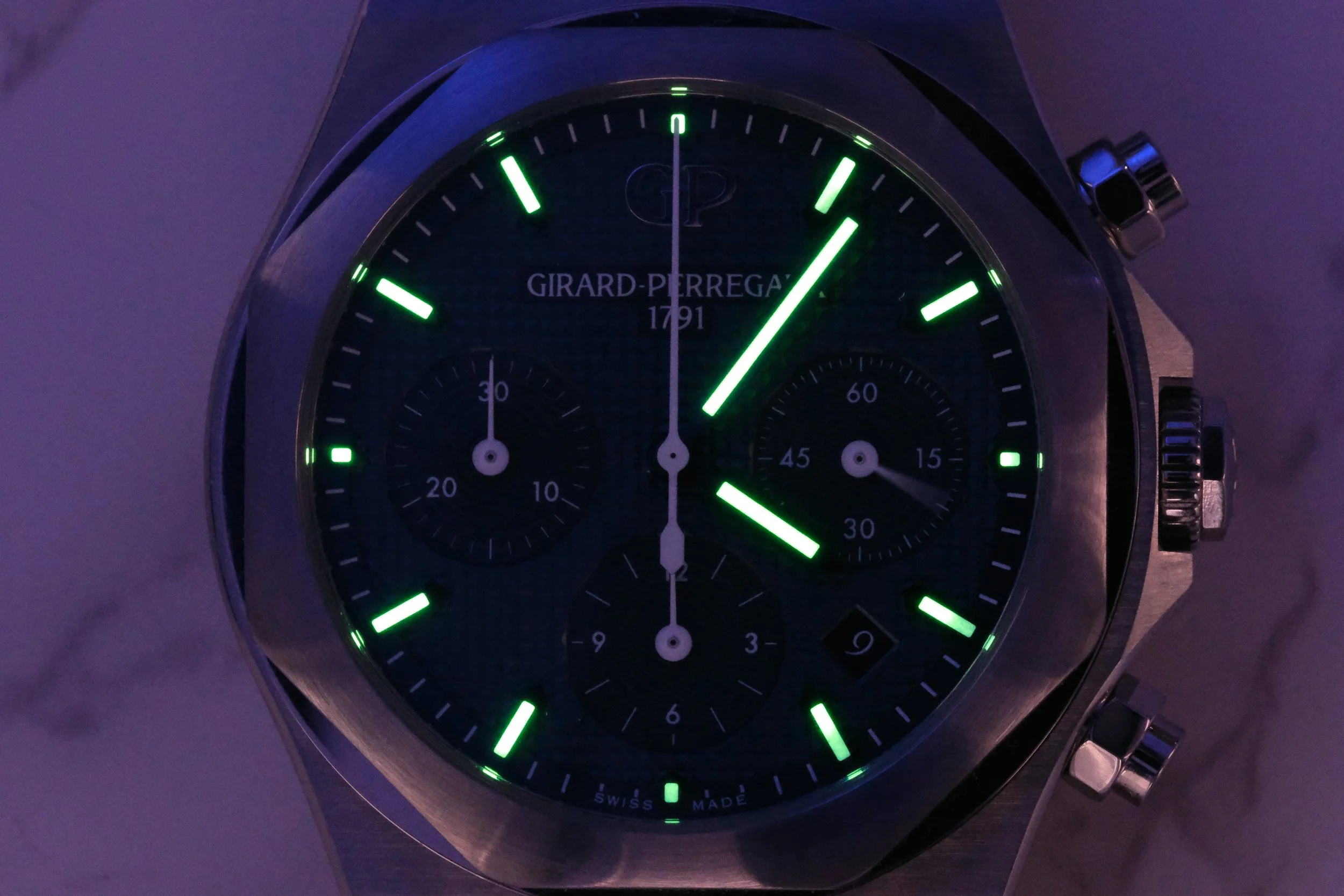HANDS ON: Girard Perregaux Laureato Chronograph 42mm Review
If you’ve been in the industry long enough, or really just more than casually like wrist watches, you’ll definitely understand the very many different luxury steel sport watches and the brands that produce them. Generally, three tend to bubble up to the surface - the Patek Philippe Nautilus, the Audemars Piguet Royal Oak, and the Vacheron Constantin Overseas. These are the “Holy Trinity” of steel sport watches, and from an industry perspective anyway, are largely heralded as such.
But, and it’s a big “But” I’ll recognize, I have a fourth contender for the heavyweight belt, and it’s probably not going to be surprising to many of ya’ll. Of course, I’m talking about the Girard-Perregaux Laureato.
Look, let’s take a reality check on where the Laureato fits in. The Laureato was produced in 1975. This was a few years after the Royal Oak was launched, and actually a little before the Nautilus and Ingenieur. So the Laureato is hands down among the same time-frame, the same aesthetic shift, and the same DNA as the many steel sports watch firsts of it’s day. So, why does it often get the shaft when talking about steel sports watches in a more modern sense? Was it because it was the only one NOT designed by Genta? Well, we can lend some credence to that, as it is far too coincidental considering the popularity of these brands at the time, as well as the heavily (er…) commonalities of each design. Or perhaps was it that it was the first in-house Swiss Made quartz movement that left it a bit neglected? I felt compelled to find out for myself, so here we have my take on the Girard Perregaux Laureato Chronograph. Let’s crack on with it.
Let’s start with the 904L 42mm stainless steel case. There is a softness to the design language and the metal. First, 904L Steel feels incredibly soft even though it’s exceptionally solid (as opposed to 316L which boasts the opposite effect). Many want to call the Laureato a mini Royal Oak, but I don’t think that’s a fair assessment. In fact, it’s much less angry than a Royal Oak (which is a matter of preference), in that the octagonal bezel isn’t necessarily the focal point, as it sits within the rounded case - Almost an anti-thesis to a Royal Oak, and certainly not a “copy” as I’ve seen a number of journalists argue. It’s thinner, with more versatile lines and less rigged bevels and angles. The Laureato is a remarkably thin chronograph, though surprisingly heavy. It’s definitely not one of those watches where you’re left wondering why it costs just shy of $20,000. It feels, fits, and wears like an item with firm luxury roots.
While the case is 42mm, I’d argue it wears a bit larger, as most chronographs do, with the sharp angle of the lugs, paired with the longer screw-down pushers, the Laureato Chronograph hugs the wrist. I have a huge pet-peeve with chronograph pushers that extend all the way to the bottom of the case, as they tend to dig, or pull, even on many of the highest luxury chronographs. I’m happy to say that Laureato does not. There is enough of a gap on the pushers that the watch fits snugly on the wrist despite a lack of micro-adjustments on the bracelet (more on that in a bit).
The Laureato brings two real stars to the show. One of those stars is the dial. Let me start by saying that on paper, this dial shouldn’t work because of just how many textures are in the same small space. First, the dial features a four-sided pyramid texture that’s complimented by smooth, but grated textured subdials. It’s literally two completely different textures melded together for a cohesive dial texture no matter which angle you look at it. In fact, when you wrist-roll the watch, you get a number of different color elements because each texture plays with light differently. It’s impossible to capture in pictures. I promise… I tried my damndest.
To further add a bit of “How does this work so well?” to the mix, the only contrasting color on the dial is the crisp white of the lume. The heat-blued hands and indices should get lost against the dial textures but they simply don’t. And it baffled me to no end, except that the texture of the hands differs from the dial, and there’s almost an optical illusion effect that makes the watch obscenely legible at a glance. The only thing I might wish is that there is a more pronounced date window, as the font on the date wheel is really thin, and since it’s actually really recessed into the dial, it can be hard to read sometimes, especially in the single-digit dates.
We’ll address the elephant in the room, which is always ALWAYS the hallmark of success with a steel sport watch, and that’s the bracelet. So, does the Laureato bracelet hold up to a luxury standard? I’ll emphatically say “Yes”. One of the most surprising things to me when I took it out of the box, was how steeply tapered the bracelet was. At first, it looks extreme, but on the wrist it’s perfect. Because of the steep angle of the lugs on the 42mm case, the bracelet taper looks and feels really natural to the curvature of the wrist (I recognize how cringy that sounds, but it’s true). It’s incredibly comfortable, and the polished center links add a sportier touch to an already sporty watch.
One thing I will say, is the way the bracelet is laid out, it’s a tad too big for a 7.5” wrist, while removing the link makes it a tad too tight. It’s unfortunate that I fall into that size medium, cause I think the fit would be perfect on even .25” difference on the wrist. Which lends way for my only criticism being there are no micro-adjustments on the Laureato - A missed opportunity in my opinion and something many have come to expect from watches in the luxury segment.
Inside the watch is the remarkably thin GP03300-0135 calibre. This is the brand’s in-house 3300 with their own chronograph module on the top. It’s got a so-so power reserve of 46-hours, which isn’t amazing for a chronograph, but isn’t unacceptable either. It features 63 jewels and a whopping 419 parts in it’s wheelhouse. It features Côtes de Genève but you won’t be able to see it, because the brand includes a stainless steel case back instead. Though, being a sport chronograph, I don’t feel cheated by this.
So, who is this watch for? Is it another option thrown into the steel sport watch craze Thunderdome? Well yes. But I’d argue there’s a lot more to it than that. For starters, it’s available. No for real. It’s available right now. You can actually go into a major retailer and buy one. In fact, both the major retailers in my city have this exact watch ready and able to be sold to a buyer that very day. No waitlists, no purchase history required.
The reality is that the Laureato is just as formidable of a sport watch as any of the “big three”, it’s just largely flying too close to the ground. It absolutely deserves the praise that it gets, and doesn’t deserve much of the hate. Sure, it may not be as prestigious as a Royal Oak, or a Nautilus, but in the case of those two, it’s largely access that people will feel impressed by. And if it’s not the access, it’s the sheer cost of buying it on the grey market. Girard Perregaux punches in the same weight class without all the baggage of getting something from the more prestigious brands. I’d recommend the Girard-Perregaux to any enthusiast looking for a solid stainless steel sport chronograph but doesn’t have the “IYKYK” brand relationships of some of its most stark competition.
So how much is the Girard Perregaux Laureato Chronograph 42mm?
Price is $18,600 USD. You can read more about this watch on the brand’s website.











